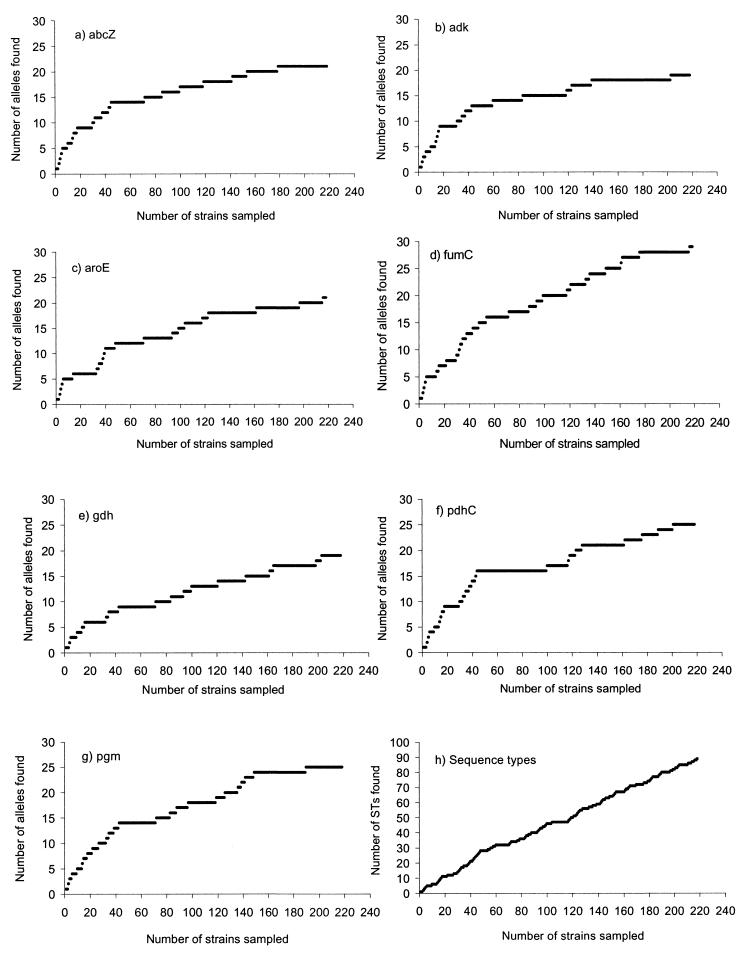Volume 38, no. 12, p. 4492-4498, 2000. We described the genetic characterization of 156 Neisseria meningitidis isolates obtained from healthy young adults in the Czech Republic during 1993. Subsequent work has established that a further 61 isolates collected during that year had been stored separately and had been overlooked. These isolates were not a random sample of those collected, as isolates with a phenotype resembling the strain responsible for a disease outbreak that year were overrepresented. All but one of the additional meningococci were isolated from individuals who were 20 to 24 years old, giving a total of 190 isolates from this age group, rather than the 130 isolates originally reported; the other isolate was from the younger cohort (age range, 15 to 19 years).
The revised multilocus sequence typing (MLST) data are available at the Neisseria MLST website (http://neisseria.mlst.net/links.htm). These data show a total of 88 sequence types (STs), which were resolved into 16 clonal complexes (lineages), with the remaining STs not presently assigned to clonal complexes. The six most prevalent clonal complexes were the ST-11 complex (33 isolates [15.2%]), the ST-44 complex (31 isolates [14.3%]), the ST-92 complex (21 isolates [9.7%]), the ST-106 complex (20 isolates [9.2%]), the ST-116 complex, (13 isolates [6%]), and the ST-53 complex (12 isolates [5.5%]). Since the original publication, some minor changes have been made to the assignment and names of the clonal complexes; for example, the ST-41 complex has been renamed the ST-44 complex. The present assignments are available at the PubMLST isolate database website (http://neisseria.mlst.net).
The principal conclusions of the paper, that the population was diverse and that this diversity was principally generated by recombination, are unaltered (Table 1; Fig. 1). However, the revised data show that the prevalence of meningococci belonging to the
TABLE 1.
Genetic Variation in MLST locia
| Locus | Size (bp) | 218 Czech carriage isolates
|
107 isolates isolated worldwide
|
No. (%) of alleles shared | No. (%) of polymorphic sites shared | ||||
|---|---|---|---|---|---|---|---|---|---|
| No. of alleles (no./100 isolates) | No. (%) of polymorphic sites | dN/dS | No. of alleles (no./100 isolates) | No. (%) of polymorphic sites | dN/dS | ||||
| abcZ | 432 | 21 (9.6) | 75 (17.4) | 0.074 | 15 (14) | 75 (17.4) | 0.05 | 10 (47.6) | 65 (86.7) |
| adk | 465 | 19 (8.7) | 25 (5.4) | 0.011 | 10 (9.4) | 17 (3.7) | 0.02 | 8 (42.1) | 15 (60.0) |
| aroE | 489 | 21 (9.6) | 135 (27.6) | 0.295 | 18 (16.8) | 166 (34) | 0.293 | 11 (52.4) | 126 (93.3) |
| fumC | 465 | 29 (13.3) | 48 (10.3) | 0.010 | 19 (17.8) | 38 (8.2) | 0.024 | 13 (44.8) | 38 (79.2) |
| gdh | 501 | 19 (8.7) | 26 (5.2) | 0.049 | 16 (15) | 28 (5.6) | 0.05 | 9 (47.4) | 24 (92.3) |
| pdhC | 480 | 25 (11.5) | 83 (17.3) | 0.068 | 24 (22.4) | 80 (16.7) | 0.07 | 15 (60.0) | 76 (91.6) |
dN/dS, the proportion of nonsynonymous to synonymous nucleotide substitutions.
FIG. 1.
The number of alleles present at the loci abcZ (a), adk (b), aroE (c), fumC (d), gdh (e), pdhC (f), and pgm (g), as well as the number of sequence types (h), plotted against the number of isolates sampled, given in numerical order of isolation.



